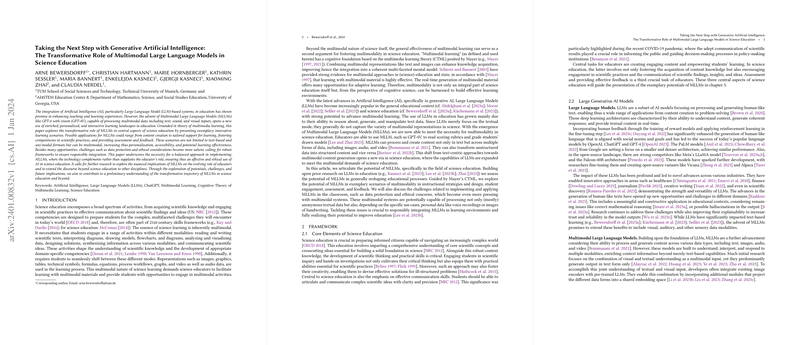Introduction
Science education is a field replete with activities that span from absorbing scientific knowledge to engaging in scientific methods and communicating scientific ideas effectively. The nature of science learning is intrinsically multimodal, necessitating the engagement with a variety of activities that pertain to different modalities, such as reading and writing scientific text, deciphering diagrams, and crafting and interpreting data visualizations. This multimodal reality is further bolstered by cognitive theories such as the Cognitive Theory of Multimedia Learning, which emphasizes the enhancement of knowledge acquisition through the combination of text and imagery.
Framework
The Role of Multimodal Learning in Science Education
Science education prepares students to handle complex realities through robust content knowledge and the cultivation of scientific practices. Engagement with scientific material is made more dynamic through multimodal learning. Combining text, images, and other sensory inputs helps learners construct an integrated mental model. Multimodal LLMs (MLLMs), such as GPT-4V, are designed to cater to the multifaceted nature of scientific education, facilitating both educators and learners in creating and engaging with multimodal content. This can potentially transform educational practices by enabling personalized content generation, tailored learning support, and multimodal assessment.
The Advancements in AI-Driven Models
Traditionally, LLMs like ChatGPT have been used extensively in education for content creation and problem-solving. The advent of MLLMs introduces the ability to process and generate content beyond text, encompassing imagery, audio, and video, thus mirroring the multimodality of science learning. They can interpret and respond to multimodal information, bridging the gap between text-centric learning and the demands of scientific education. MLLMs could support the essential tasks of educators by providing comprehensive analysis, generating novel material, and offering assessment and feedback across diverse modalities.
Applications in Science Education
MLLMs open up a range of applications within science education, from content creation to learning support and assessments. They provide the tools to create adaptive, multimodal learning materials, which are accessible to students with various needs. By transforming and supplementing textual information with visuals, MLLMs promote deeper understanding and engagement with scientific content. Additionally, their ability to provide instantaneous, personalized feedback on both textual and visual student work represents a significant advancement for learning processes and outcomes.
Challenges and Considerations
Despite the immense potential of MLLMs, the integration of these technologies into the classroom must be approached with caution. Challenges like minimal guidance, cognitive load, and the need for balance in technology use remain salient. There are also ethical considerations, including data privacy, biased content, and reliable assessment. As such, it is vital for educators to play a pivotal role in mediating the use of MLLMs, ensuring they serve as an enhancement, not a replacement, for human interaction and learning. Further research is needed to explore the nuanced implications of MLLMs on teacher roles and the education system as a whole.
Conclusion
As science education continues to evolve, MLLMs promise a trajectory where educational processes are enhanced and personalized. These models can potentially give rise to learning environments that respond adaptively to student needs, thus improving learning experiences significantly. However, the successful incorporation of MLLMs requires a thoughtful, balanced approach, prioritizing the enhancement of human-centric teaching and comprehensive understanding of scientific concepts.
